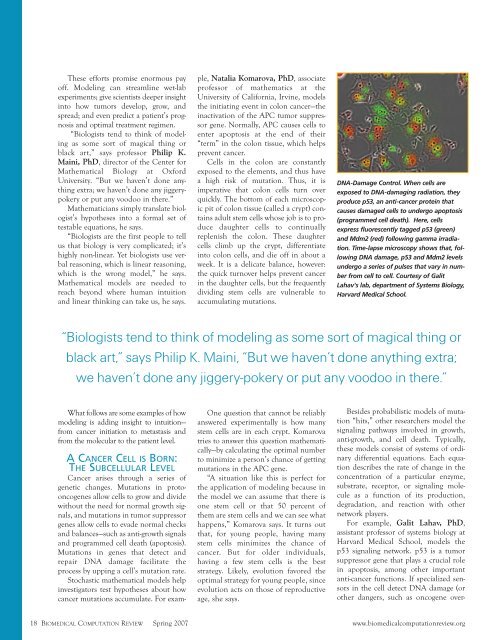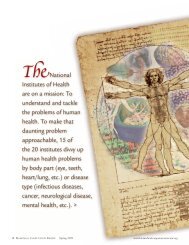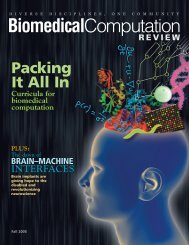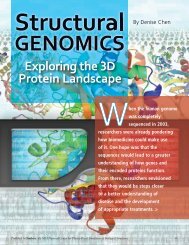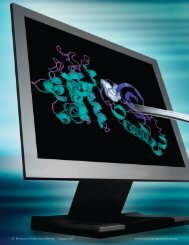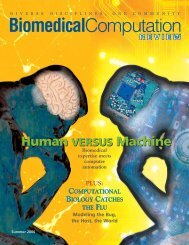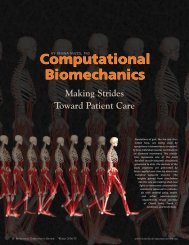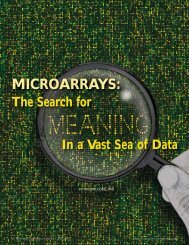Modeling Cancer Biology - Biomedical Computation Review
Modeling Cancer Biology - Biomedical Computation Review
Modeling Cancer Biology - Biomedical Computation Review
You also want an ePaper? Increase the reach of your titles
YUMPU automatically turns print PDFs into web optimized ePapers that Google loves.
These efforts promise enormous pay<br />
off. <strong>Modeling</strong> can streamline wet-lab<br />
experiments; give scientists deeper insight<br />
into how tumors develop, grow, and<br />
spread; and even predict a patient’s prognosis<br />
and optimal treatment regimen.<br />
“Biologists tend to think of modeling<br />
as some sort of magical thing or<br />
black art,” says professor Philip K.<br />
Maini, PhD, director of the Center for<br />
Mathematical <strong>Biology</strong> at Oxford<br />
University. “But we haven’t done anything<br />
extra; we haven’t done any jiggerypokery<br />
or put any voodoo in there.”<br />
Mathematicians simply translate biologist’s<br />
hypotheses into a formal set of<br />
testable equations, he says.<br />
“Biologists are the first people to tell<br />
us that biology is very complicated; it’s<br />
highly non-linear. Yet biologists use verbal<br />
reasoning, which is linear reasoning,<br />
which is the wrong model,” he says.<br />
Mathematical models are needed to<br />
reach beyond where human intuition<br />
and linear thinking can take us, he says.<br />
A CANCER CELL IS BORN:<br />
THE SUBCELLULAR LEVEL<br />
<strong>Cancer</strong> arises through a series of<br />
genetic changes. Mutations in protooncogenes<br />
allow cells to grow and divide<br />
without the need for normal growth signals,<br />
and mutations in tumor suppressor<br />
genes allow cells to evade normal checks<br />
and balances—such as anti-growth signals<br />
and programmed cell death (apoptosis).<br />
Mutations in genes that detect and<br />
repair DNA damage facilitate the<br />
process by upping a cell’s mutation rate.<br />
Stochastic mathematical models help<br />
investigators test hypotheses about how<br />
cancer mutations accumulate. For example,<br />
Natalia Komarova, PhD, associate<br />
professor of mathematics at the<br />
University of California, Irvine, models<br />
the initiating event in colon cancer—the<br />
inactivation of the APC tumor suppressor<br />
gene. Normally, APC causes cells to<br />
enter apoptosis at the end of their<br />
“term” in the colon tissue, which helps<br />
prevent cancer.<br />
Cells in the colon are constantly<br />
exposed to the elements, and thus have<br />
a high risk of mutation. Thus, it is<br />
imperative that colon cells turn over<br />
quickly. The bottom of each microscopic<br />
pit of colon tissue (called a crypt) contains<br />
adult stem cells whose job is to produce<br />
daughter cells to continually<br />
replenish the colon. These daughter<br />
cells climb up the crypt, differentiate<br />
into colon cells, and die off in about a<br />
week. It is a delicate balance, however:<br />
the quick turnover helps prevent cancer<br />
in the daughter cells, but the frequently<br />
dividing stem cells are vulnerable to<br />
accumulating mutations.<br />
DNA-Damage Control. When cells are<br />
exposed to DNA-damaging radiation, they<br />
produce p53, an anti-cancer protein that<br />
causes damaged cells to undergo apoptosis<br />
(programmed cell death). Here, cells<br />
express fluorescently tagged p53 (green)<br />
and Mdm2 (red) following gamma irradiation.<br />
Time-lapse microscopy shows that, following<br />
DNA damage, p53 and Mdm2 levels<br />
undergo a series of pulses that vary in number<br />
from cell to cell. Courtesy of Galit<br />
Lahav's lab, department of Systems <strong>Biology</strong>,<br />
Harvard Medical School.<br />
“Biologists tend to think of modeling as some sort of magical thing or<br />
black art,” says Philip K. Maini, “But we haven’t done anything extra;<br />
we haven’t done any jiggery-pokery or put any voodoo in there.”<br />
What follows are some examples of how<br />
modeling is adding insight to intuition—<br />
from cancer initiation to metastasis and<br />
from the molecular to the patient level.<br />
One question that cannot be reliably<br />
answered experimentally is how many<br />
stem cells are in each crypt. Komarova<br />
tries to answer this question mathematically—by<br />
calculating the optimal number<br />
to minimize a person’s chance of getting<br />
mutations in the APC gene.<br />
“A situation like this is perfect for<br />
the application of modeling because in<br />
the model we can assume that there is<br />
one stem cell or that 50 percent of<br />
them are stem cells and we can see what<br />
happens,” Komarova says. It turns out<br />
that, for young people, having many<br />
stem cells minimizes the chance of<br />
cancer. But for older individuals,<br />
having a few stem cells is the best<br />
strategy. Likely, evolution favored the<br />
optimal strategy for young people, since<br />
evolution acts on those of reproductive<br />
age, she says.<br />
Besides probabilistic models of mutation<br />
“hits,” other researchers model the<br />
signaling pathways involved in growth,<br />
anti-growth, and cell death. Typically,<br />
these models consist of systems of ordinary<br />
differential equations. Each equation<br />
describes the rate of change in the<br />
concentration of a particular enzyme,<br />
substrate, receptor, or signaling molecule<br />
as a function of its production,<br />
degradation, and reaction with other<br />
network players.<br />
For example, Galit Lahav, PhD,<br />
assistant professor of systems biology at<br />
Harvard Medical School, models the<br />
p53 signaling network. p53 is a tumor<br />
suppressor gene that plays a crucial role<br />
in apoptosis, among other important<br />
anti-cancer functions. If specialized sensors<br />
in the cell detect DNA damage (or<br />
other dangers, such as oncogene over-<br />
18 BIOMEDICAL COMPUTATION REVIEW Spring 2007 www.biomedicalcomputationreview.org


